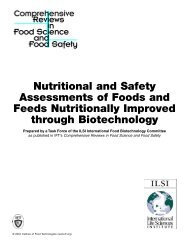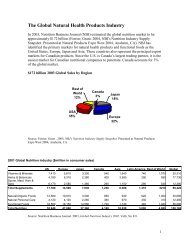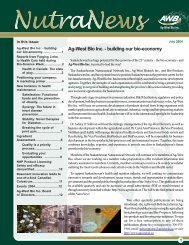Beyond Borders: Global biotechnology report 2010
Beyond Borders: Global biotechnology report 2010
Beyond Borders: Global biotechnology report 2010
Create successful ePaper yourself
Turn your PDF publications into a flip-book with our unique Google optimized e-Paper software.
Turbulent financial markets<br />
and the impact on biotech<br />
The <strong>biotechnology</strong> industry and financial<br />
community are inextricably linked, and for<br />
good reason. Biotech R&D is exceptionally<br />
expensive and time consuming, making it<br />
one of the most capital-intensive industries.<br />
Since the vast majority of biotech<br />
companies have no operating revenues,<br />
raising funding is a constant and unrelenting<br />
focus of management and boards.<br />
Much has changed since Genentech’s<br />
remarkable and historic IPO in 1980. On<br />
the first day of trading, the Company’s<br />
shares soared from the US$35 offer price<br />
to more than US$80 — an unprecedented<br />
performance at the time. A cascade of<br />
public biotech offerings soon followed<br />
(Cetus, for instance, raised an astonishing<br />
US$122 million in 1981), fueled by<br />
exuberant coverage in the lay press about<br />
the new world of molecular biology.<br />
Reporters talked breathlessly about “magic<br />
bullets” that would develop new cures for<br />
diseases ranging from cancer to diabetes,<br />
while new technologies promised to make<br />
R&D far quicker and cheaper.<br />
Today, reality reigns supreme, and accessing<br />
capital has become far more challenging<br />
and expensive for earlier-stage companies.<br />
The turmoil in financial markets has taken<br />
a toll on biotech firms, but the situation is<br />
not completely dire. We need to place the<br />
current situation in context and understand<br />
how it has affected longer-term capital<br />
market trends to understand this impact.<br />
One of the most significant consequences<br />
has been the virtual closure of the<br />
traditional IPO market for emerging<br />
venture-backed companies. This is not<br />
solely attributable to today’s unreceptive<br />
markets for offerings of younger, stillunprofitable<br />
companies; rather, it also<br />
reflects some longer-term, industry-specific<br />
trends. First, the market performance of<br />
biotech IPOs in recent years has largely<br />
been abysmal. Second, a typical biotech IPO<br />
provides only enough capital to extend the<br />
R&D “runway,” but not enough to bring a<br />
company to profitability and self-sustaining<br />
cash flow. This has caused many former IPO<br />
investors to back away and focus instead<br />
on private investments in public companies<br />
(PIPEs). These financings are executed in<br />
a very short time frame, and at a smallto-moderate<br />
discount to the company’s<br />
share price. PIPEs give firms sufficient<br />
capital to propel them to important valuecreating<br />
milestones — which has often<br />
driven significant post-offering market<br />
price increases. Investors get “instant<br />
gratification,” and since success breeds<br />
imitation, the PIPE markets have been<br />
noticeably robust.<br />
Big pharma’s role in providing biotech<br />
companies with fresh capital for<br />
R&D — and giving venture investors a<br />
pathway to liquidity — has been vital.<br />
The two sides have a naturally symbiotic<br />
relationship: pharma companies have been<br />
capital-long and opportunity-short with<br />
respect to their internal research programs,<br />
while biotech firms have been short of<br />
capital but rich with research opportunities.<br />
This will likely continue, not least because<br />
of the abundance of important prescription<br />
drugs scheduled to go off-patent between<br />
<strong>2010</strong> and 2015. But here, too, things have<br />
changed in the current market environment.<br />
In the early 2000s, big pharma players<br />
frequently acquired biotech firms outright.<br />
Today, acquisitions are instead most often<br />
structured as sequential payments — even<br />
though the pharma buyer owns 100% of<br />
the company, the deal includes a series<br />
of contingent milestone payments. The<br />
Fred Frank<br />
Peter J Solomon Company<br />
Vice Chairman<br />
upfront cash consideration may equate to<br />
one-to-two times the investments in the<br />
biotech company to date, while milestone<br />
payments account for the vast majority<br />
of the announced “acquisition price.”<br />
Such transactions represent a new model<br />
of shared risk that we will likely see in<br />
most pharma-biotech transactions. While<br />
pharma-biotech deals will continue, a<br />
mature, balanced relationship is evolving<br />
to reflect the comparative strengths of<br />
the participants.<br />
In summary, remember the quote from<br />
Walt Whitman: “Traveling roads all even and<br />
peaceful you learn’d from joys and prosperity<br />
only,/But now, ah now, to learn from crises<br />
of anguish ...” Let’s hope these crises of<br />
anguish are sculpting a viable, mutually<br />
beneficial accommodation — especially<br />
so since the ultimate beneficiaries<br />
are patients.<br />
75








